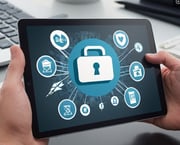

LiveStream Presentation Notes:
Making your password an asset, not a liability
- Use a password manager
- Features typically include
- Ability to generate strong passwords automatically
- Ability to share passwords with trusted people
- Access from anywhere via the web or a mobile app
- Emergency access. In the event something happens to you, you can designate one or more trusted people that can access your vault after a period of time
- Audits your existing passwords and makes recommendations (too weak, used in multiple accounts, etc.)
- Inexpensive (free to ~$6 month depending on features)
- Ability to safeguard your vault with 2FA
- Features typically include
- Use 2FA whenever possible
- Avoid SMS, use only as a last resort.
Encryption Tips for the non-geek:
- iPhone/iPad
- Most modern apple devices encrypt by default
- Depending on the age, it’s protected by a 4 or 6 digit PIN
- Turn off “Simple Passcode” to use a more complex password
- Set “Require Passcode” to “Immediately”
- Confirm at the bottom of the Passcode settings page it says “Data protection is enabled”
- Android
- The latest versions are encrypted by default
- SD cards are not encrypted by default, if you use one you must turn it on in Settings –>Security
- Confirm your phone is encrypted by going to Settings –>Security –>Encryption
- If you only see the option to encrypt an SD card and your phone is newer it’s likely already encrypted
- Laptop
- Windows:https://support.microsoft.com/en-us/help/4028713/windows-10-turn-on-device-encryption
- Pro/Enterprise
- Bitlocker
- Home
- Limited encryption, still useful (no business features included)
- Pro/Enterprise
- Mac: https://support.apple.com/en-us/HT208344
- Modern Macs are encrypted by default
- Turn on FileVault so your Mac requires a password to decrypt your data
- Windows:https://support.microsoft.com/en-us/help/4028713/windows-10-turn-on-device-encryption
“Weaponize your portable device”
- Encrypt it
- Protect it with a strong password
- Enable “Find me” options
- Windows 10: https://www.laptopmag.com/articles/set-up-use-find-my-device-how-to
- Settings –>Find my device –>Turn on (you must sign in with your Microsoft account)
- Locate it using https://account.microsoft.com/devices
- Android
- Tied to your gmail account
- Locate it using https://www.google.com/android/find
- Macbook:https://www.imore.com/how-set-and-use-find-my-mac,https://support.apple.com/explore/find-my-iphone-ipad-mac-watch
- Turn on System Preferences –>Security and Privacy
- Locate it using iCloud.com and sign in with your Apple ID and password
- iPhone
- Download and install the app: https://itunes.apple.com/us/app/find-my-iphone/id376101648?mt=8
- Locate your device: https://support.apple.com/explore/find-my-iphone-ipad-mac-watch
- Windows 10: https://www.laptopmag.com/articles/set-up-use-find-my-device-how-to
- Use a VPN to stay secure, especially if traveling abroad.
- Conceals your online activity
- Some VPNs allow you to use anonymized servers, allowing access to the real web even in countries with internet censorship
- Safeguards your use of WIFI networks, even open networks (i.e. no WIFI password)
Share this entry
-
Share on Facebook
Share on Facebook
-
Share on Twitter
Share on Twitter
- Share on Google+
-
Share on Pinterest
Share on Pinterest
- Share on Linkedin
- Share on Tumblr
- Share on Vk
- Share on Reddit
- Share by Mail
Subscribe to our Newsletter
Don’t miss out on the latest news from Entech. Submit your e-mail to subscribe to our monthly e-mail list.
.png?width=360&height=300&name=Logo%20(2).png)









